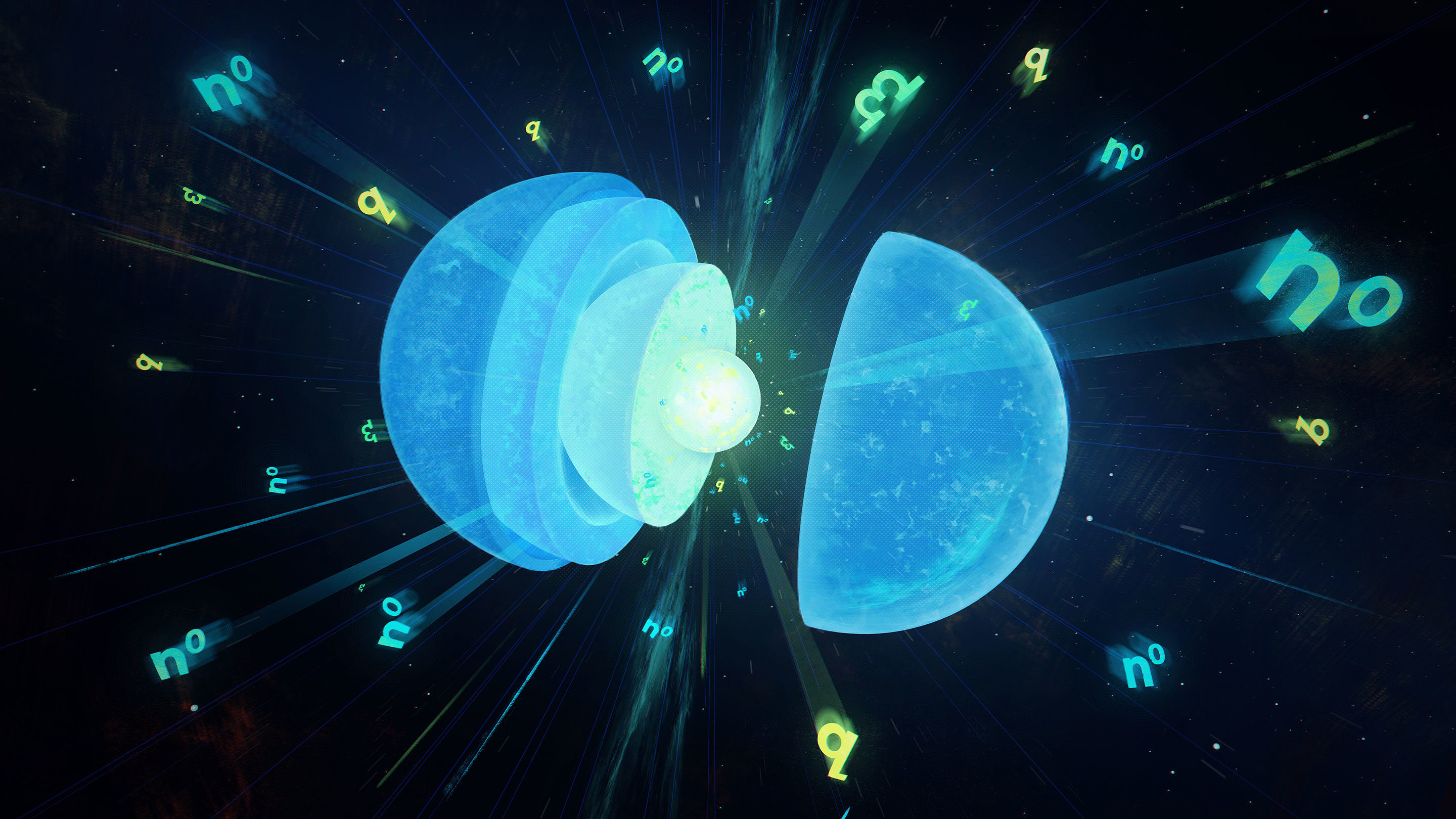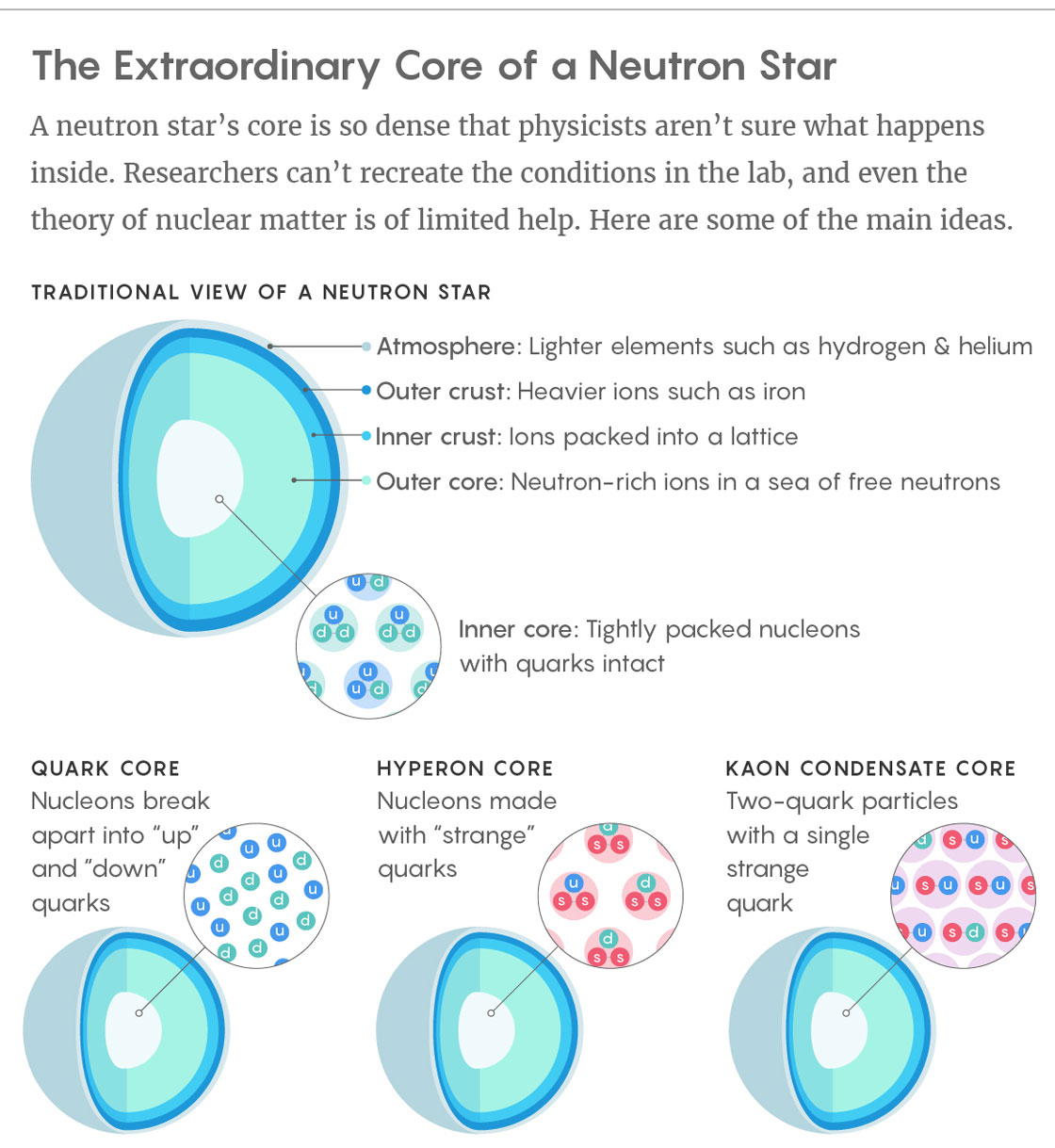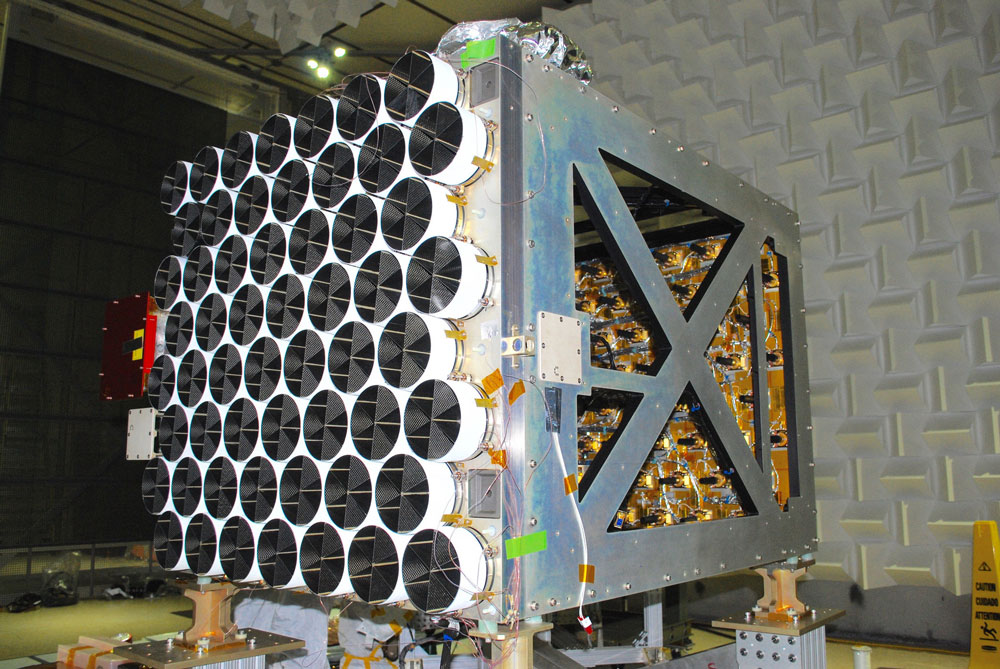Soft or hard? The debate about what is inside a neutron star
The core of a neutron star is in such an extreme state that physicists cannot agree on what is happening inside it. But a new space experiment - and several colliding neutron stars - should show whether neutrons can break

Warnings started coming early in the morning of August 17th. Gravitational waves generated by the collision of two neutron stars - the dense cores of dead stars - washed the Earth. More than 1000 physicists at the aLIGO Observatory (Advanced Laser Interferometer Gravitational-Wave Observatory - laser-interferometric gravitational-wave observatory) were quick to decipher the vibrations of space-time, swept through the detectors like a long thunderclap. Thousands of astronomers fought for the right to witness the afterglow. However, officially, all this confusion was kept secret. It was necessary to collect data and write research papers. The outside world was not supposed to know about it for two more months.
This strict ban put Jocelyn Reed and Caterino Chatzianoou , two members of the LIGO collaboration, in an awkward position. On the afternoon of the 17th, they were supposed to hold a conference on what is happening in the unimaginable conditions of the inside of a neutron star. And their theme was how the merging of two neutron stars should take place. “We took a break, sat down and stared at each other,” says Reed, a professor at the University of California at Fullerton. “So how do we do this?”
For decades, physicists argued about whether or not neutron stars contain new types of matter, appearing when a star breaks the familiar world of protons and neutrons and creates new interactions between quarks or other exotic particles. The answer to this question would also shed light on the astronomical mysteries surrounding the supernovae and the appearance of heavy elements like gold.
')
In addition to observing collisions with LIGO, astrophysicists developed creative methods for sensing a neutron star. The task is to find out any properties of its inner layers. But the signal that came to LIGO, and others like it — emitted by two neutron stars orbiting around a common center of mass, attracting each other, and finally cutting through — offers a completely new approach to the problem.
Strange matter
The neutron star is a compressed core of a massive star, very dense coals left after a supernova. Its mass is comparable to the sun, but it is compressed to the size of the city. Thus, neutron stars serve as the densest reservoirs of matter in the Universe - “the last substance at the turn of the black hole,” says Mark Alford , a physicist at the University of Washington at St. Louis.
Having drilled such a star, we would have approached the leading edge of science. A couple of centimeters of normal atoms — mostly iron and silicon — lie on the surface, like a bright red covering of the densest sucking sweets of the Universe. Then the atoms are so strongly compressed that they lose electrons that fall into the common sea. Deeper still, protons begin to turn into neutrons that are so close that they begin to overlap each other.

The extraordinary core of a neutron star. Physicists are still discussing what exactly is inside it. Here are some basic ideas.
Traditional theory
Atmosphere - light elements like hydrogen and helium
Outer shell - iron ions
Inner shell - ion lattice
The outer core - neutron-rich ions in a sea of free neutrons
What's inside?
- In the quark core, neutrons fall apart into upper and lower quarks.
- In the hyperon, there are neutrons consisting of strange quarks.
- In kaonnom, two-quark particles with one strange quark.
Theorists argue about what happens next, when the density of 2-3 times begins to exceed the density of the normal atomic nucleus. From the point of view of nuclear physics, neutron stars can simply consist of protons and neutrons, that is, nucleons. “Everything can be explained by variations of the nucleons,” says James Lattimer , an astrophysicist at the University of Stony Brook.
Other astrophysicists believe otherwise. Nucleons are not elementary particles. They consist of three quarks [ in fact, no - approx. trans. ]. Under incredibly strong pressure, quarks can form a new state - quark matter. “Nucleons are not billiard balls,” says David Blaschke , a physicist at the University of Wroclaw in Poland. “They are more like cherries. You can compress them a little, but at some point you will crush them. ”
But some people consider quark jam too simple. Theorists have long thought that layers of stranger particles may appear inside a neutron star. The energy of compressible neutrons can go into the creation of heavier particles containing not only the upper and lower quarks of which protons and neutrons are composed, but also heavier and exotic strange quarks.
For example, neutrons can give way to hyperons , three-quark particles, which include at least one strange quark. In laboratory experiments, hyperons were obtained, but they almost immediately disappeared. Inside neutron stars, they can stably exist for millions of years.
Alternatively, the hidden depths of neutron stars can be filled with kaons - also consisting of strange quarks - gathering in one piece of matter that is in a single quantum state.
But for several decades this field of research has been at a standstill. Theorists invented ideas about what could happen inside neutron stars, but this environment is so extreme and unfamiliar that experiments on Earth cannot recreate the necessary conditions. At the Brookhaven National Laboratory and at CERN, physicists collide with heavy nuclei, such as gold and lead. This creates a state of matter resembling a soup of particles, in which there are free quarks, known as quark-gluon plasma . But this substance turns out to be rarefied, not dense, and its temperature in billions or trillions of degrees turns out to be much higher than that of the inside of a neutron star, within which relatively cool temperatures of millions of degrees reign.
Even a few decades old theory describing quarks and nuclei, " quantum chromodynamics " or QCD, cannot provide answers to these questions. The calculations required to study QCD in relatively cold and dense environments are so terribly complex that they cannot even be performed on a computer. Researchers have to be content with excessive simplifications and various tricks.
The only option is to study the neutron stars themselves. Unfortunately, they are very far away, dim, and it is very difficult to measure anything but the most basic properties from them. Worse, the most interesting physics occurs beneath their surface. “The situation resembles a laboratory in which something amazing is happening,” says Alford, “while you can only see the light from its windows.”
But with the new generation of experiments, theorists may finally have a good look at it soon.


NICER tool right before launch on the ISS. It tracks the x-rays of neutron stars.
Soft or hard?
Whatever is in the nucleus of a neutron star - free quarks, kaon condensate, hyperons, or good old nucleons - this material must hold against crushing gravity, exceeding solar. Otherwise, the star would collapse into a black hole. But different materials can be compressed by gravity in varying degrees, which determines the maximum possible weight of a star for a given physical size.
Astronomers forced to stay outside unravel this chain, trying to understand what neutron stars consist of. And for this it would be very good to know how soft or hard they are to compress. To find out, astronomers need to measure the masses and radii of various neutron stars.
Among neutron stars, pulsars are the easiest to weigh: fast-rotating neutron stars, whose radio rays pass through the Earth with each turn. About 10% of the 2500 known pulsars belong to binary systems. In the course of the movement of these pulsars, those of their impulses that must reach the Earth with equal intervals, produce a movement of the pulsars and their position in orbits. And knowing the orbits, astronomers can, using the laws of Kepler and the additional amendments of Einstein and GTR, to find the masses of these pairs.
So far, the discovery of unexpectedly healthy neutron stars has been the biggest breakthrough. In 2010, a team led by Scott Ransom at the Virginia National Radio Astronomy Observatory announced that it had measured the mass of a pulsar and found it equal to two solar - which is much more than what had been previously seen. Some even doubted the possibility of the existence of such neutron stars; This leads to serious consequences for our understanding of the behavior of atomic nuclei. "Now this is one of the most frequently cited works on observing pulsars, and all thanks to nuclear physicists," says Ransom.
In accordance with some models of neutron stars claiming that gravity should compress them strongly, an object of such a mass should collapse into a black hole. In this case, kaon condensates will suffer, since they are quite soft, and this is not very good for some variants of quantum matter and hyperons, which would also shrink too much. The measurement was confirmed by the discovery of another neutron star, having a mass of two solar, in 2013.

Feryal Ozel, an astrophysicist from the University of Arizona, carried out measurements, from which it follows that the nuclei of neutron stars contain exotic matter
With radii everything is a bit more complicated. Astrophysics, for example, Feryal Ozel of the University of Arizona, has developed various techniques for calculating the physical size of neutron stars by observing X-rays emanating from their surface. Here is one way: you can measure the total X-ray radiation, use it to estimate the surface temperature, and then calculate the size of a neutron star that can emit such waves (by adjusting for how they bend due to gravity). You can also search for hot spots on the surface of a neutron star, constantly appearing and disappearing from view. The star's strong gravitational field will change the light impulses depending on these hot spots. Having understood the star's gravitational field, you can recreate its mass and radius.
If you believe these calculations Ozel, it turns out that although neutron stars are quite heavy, their size is in the range of 20-22 km in diameter.
Accepting the fact that neutron stars are small and massive “drives you into frames, in a good way,” says Ozel. She says that neutron stars filled with interacting quarks should look like this, and for neutron stars consisting only of nucleons, the radius should have been large.

James Lattimer, an astrophysicist from the University of Stony Brook, claims that neutrons in neutron star nuclei remain intact
But Lattimer, among other critics, has doubts about the assumptions used in X-ray measurements - he believes that they are wrong. He thinks that they may unduly reduce the radius of the stars.
Both competing parties believe that their dispute will soon be resolved. Last June, the SpaceX 11th mission delivered a 372 kg box containing the Nayser X-ray telescope to the ISS. The nicer, currently collecting data, was created to determine the size of neutron stars through the study of hot spots on their surface. The experiment should produce the best measurements of the radii of neutron stars, including pulsars, the masses of which are measured.
“We are all looking forward to the results,” says Blaschke. Accurately measured mass and radius of even a single neutron star will immediately mark out many plausible theories describing their internal structure, and leave only those that give a certain ratio of size and weight.
And now LIGO has also joined the experiments.
At first, the signal that Reed discussed for coffee on August 17 was treated as a result of a collision of black holes, rather than neutron stars. And it made sense. All previous signals from LIGO were received from black holes, more compliant objects from a computational point of view. But lighter objects participated in the generation of this signal, and it lasted much longer than black holes merge. “It is clear that this was not the kind of system on which we trained,” said Reed.
When two BH come together in a spiral, they emit orbital energy into space, time in the form of a gravitational wave. But at the last second of a new 90-second signal received by LIGO, each object experienced something that the BH did not experience: it was deformed. A pair of objects began to stretch and compress the matter of each other, creating waves, extracting the energy of their orbits. This caused them to collide faster than they would otherwise.
After several months of frantic computer simulation work, the Reed group at LIGO released its first measurement of the effects of these waves on a signal. So far, the team has only an upper limit - which means that the effect exerted by the waves is weak or even imperceptible. And this means that neutron stars are physically small, and their matter is held around the center in a very dense state, which prevents its tidal stretching. “I think that the first measurement through gravitational waves seems to confirm what the x-ray observations were talking about,” says Reed. But this is not the end. She expects that more complex modeling of the same signal will produce a more accurate estimate.
Nayser and LIGO provide new ways to study neutron stars, and many experts are optimistic that in the next few years there will be unequivocal answers to the question of the resistance of the material of gravity. But theorists, for example, Alford, warn that a simple measurement of the softness of the matter of a neutron star will not give complete information about it.
Other signs may say more. For example, ongoing observations on the cooling rate of neutron stars should allow astrophysicists to speculate about the particles inside them and their ability to emit energy. Alternatively, studying the slowing down of their rotation can help determine the viscosity of their viscera.
But, in any case, simply knowing at what point the phase transition of matter occurs and what it turns into is a worthy task, Alford said. “Studying the properties of matter that exists in different conditions is, in general, physics,” he says.
Source: https://habr.com/ru/post/371077/
All Articles